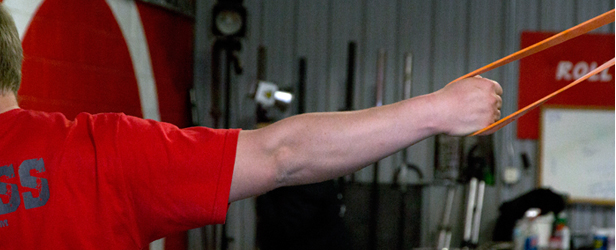
Any strength coach or fitness enthusiast can get onto YouTube and find some very interesting and entertaining videos about the world of strength and conditioning. Which one do you think has gotten more views?
The NFL Defensive Lineman jumping on a 50-inch box after doing box squats with chains.
OR
The 13-year-old boy with bad hip mobility and hamstring flexibility learning how to do a proper bodyweight squat.
I think the answer is common sense. There is a reason that NFL guys make millions—they are freaks of nature, and they are fun to watch.
Let's face it, training athletes that play sports on TV is fun and glamorous. Whether it is an MMA fighter on Pay-Per-View, a college football player on ESPN, or a volleyball player on the Big Ten Network, any strength coach experiences a sense of pride when watching his or her prized clients in the big moment. It also looks great when those athletes are working out in the gym when parents and potential clients walk in the door.
So, all you have to do is find a warehouse; buy a ton of weights, sleds, and boxes; and create a fancy website to make all of your training dreams come true. You will have a six-figure income by training the top athletes in the world, plus you can sell videos of all your training footage online for extra income...
In the words of ESPN's Lou Corso, "NOT SO FAST MY FRIEND!"
Think about this: On your average high school football team, what percentage of kids will play at the Division 1 or 2 level? .002% ? 1%? 3%? Maybe 5-10% on the best teams?
What about the other 90-99% of the kids who are on the team? Who is training them? What if those kids got bigger, faster, and stronger?
I have this conversation with my interns and young trainers all the time. I have been in business for 13 years, and I would say that there are less than 20 professional athletes and around 50 Division I athletes (most were my clients when they were in high school) that have walked through my door. Keep in mind, most of them can only train for a few weeks at a time. That is not exactly going to pay the bills or put food on my table. Taking the kids who are mediocre athletes that sit the bench and making them contributors on JV or varsity teams is where the money is at for new coaches who are trying to build a reputation. Think about how many kids in your community fit that description. Now think about how many kids have full rides to Division I universities. It might make you want to rethink the business model of training "Elite Athletes." I love to train the elite level guys and girls, but from time to time, I have to remind myself of how I became successful. It was, without question, from turning the mediocre athlete into a relevant one.
Take a look online and see how much training information is out there:
- Contrast Training
- Max Effort Training
- Dynamic Effort
- Westside Periodization
- Concurrent Periodization
- Olympic Lifting programs
- Acceleration programs
- KB complexes
The amount of great blogs, videos, and ebooks is almost endless. However, most of that information has been created by trainers who are GREAT COACHES that have paid their dues.
Coaching = Teaching
This goes in line with Mike Boyle's post from recent weeks on how strength coaches gain their 10,000 hours of experience in order to be an expert. Should half of it come from research and the other half from teaching? The ratio can certainly be adjusted, but if you aspire to be a great strength coach, you better learn how to teach. There is no better way to become a good teacher than to teach those who have a lot to learn. This is why most of my interns spend a lot of their time instructing my beginner athletes.
The point of this article is not to discourage trainers or strength coaches from aspiring to train elite level athletes. If you put your time in and work hard, those clients will come. If you get lucky and know the right people, it might come very quickly. However, the point is that learning how to train the less athletic population will not only make you a better coach, but it will also give you a much better chance of financially succeeding in the private sector. Even if your goal is to become a strength coach at the collegiate level, trust me, you will see tons of dysfunctional athletes. The very best coaches can adapt their training model in order to meet the needs of every athlete at any level, so that each individual experiences success within the program. I challenge all new strength coaches to find a client that is low functioning and make them better—a lot better. I promise you, it will pay off.










